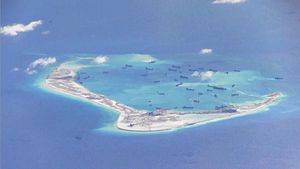Reuters has reported that China is completing new structures on several islands in the South China Sea’s Spratly Islands chain that appear intended to house new long-range surface-to-air missiles (SAMs). The structures follow revelations from the Asia Maritime Transparency Initiative (AMTI) last December that China had installed shorter ranged point-defense weapons on all seven features in the Spratlys that it occupies. The move brings China closer to breaking its pledge not to militarize the islands but does not alter the strategic balance in the South China Sea yet.
New imagery from AMTI shows the structures nearing completion on Fiery Cross, Mischief, and Subi reefs. AMTI analysts also speculate that the structures could house erector-launchers for advanced SAMs like the HQ-9, which China has previously deployed to its base on Woody Island in the Paracels. U.S. Defense officials previously revealed to Fox News that China appeared to be storing large numbers of advanced SAM systems on Hainan Island that it might eventually deploy to its bases on disputed South China Sea islands.
Any new Chinese military systems in the Spratlys possess special significance because of President Xi Jinping’s 2015 pledge that China would not militarize islands in the chain. However, western analysts and the Chinese government often disagree about what constitutes militarization, and even President Xi’s original statement hedges more than the common “pledge” characterization implies. While framed as a pledge, President Xi said only that China did not “intend” to militarize the islands.
Nevertheless, China has long carved out exceptions to its pledge for “defense facilities” that it asserts are not militarization. The installation of long-range over-the-horizon radars and short range point defense weapons systems have been pointed to as evidence that China has broken its pledge. But these systems are better thought of as enablers of militarization as they cannot project power themselves the way that long-range missiles or military aircraft could. Thus, references to their installation as militarization hinge more on a technicality than a strategically meaningful shift in the balance of regional power.
But if China does deploy systems like the HQ-9 to islands in the Spratlys, it could then deny airspace around the islands to adversary aircraft, a move that more plausibly counts as militarization. According to the U.S. Office of Naval Intelligence, the HQ-9 has a range of approximately 55 nautical miles, and an extended-range version may reach out nearly 80 nautical miles, roughly equivalent to the SM-2 surface-to-air missile. The U.S. Navy deploys the SM-2 on its cruisers and destroyers to provide ship self-defense and area air defense, in which a more capable air-defense ship provides a protective ‘bubble’ for less capable ships to operate within.
The overlapping ranges of SAM systems deployed on a network of islands in the Spratlys might allow China to establish control over a considerable airspace. But U.S. ships and aircraft often operate in proximity to Chinese destroyers that are also armed with HQ-9s, so their deployment to the Spratlys would not inhibit peacetime U.S. operations in the South China Sea. And while their presence would complicate combat operations against the island bases, being installed in fixed emplacements rather than mobile launchers also makes them easier targets.
The deployment of missiles to the Spratlys is a potentially destabilizing development in the South China Sea, but it is important not to exaggerate what it says about Chinese intent. While HQ-9s or some similar SAM would extend China’s reach, they are still a predominantly defensive weapon.
In combination with the point defense systems that AMTI has already identified on the Chinese occupied Spratly features, the HQ-9 would most likely be part of a layered defense for its bases. During an attack by strike aircraft or cruise missiles the HQ-9 would engage incoming targets first using their greater range, while the short-range point defense systems would provide a last ditch defense against any cruise missiles missed by the HQ-9s.
China’s deployment of advanced SAMs pushes the envelope of what could plausibly be considered non-militarization “defense facilities,” but remains largely consistent with the caveats the Chinese government has claimed for it bases in the Spratlys. When asked about the new structures last week, the Chinese Ministry of Foreign Affairs called its construction “necessary and appropriate national defense facilities” to protect its territorial sovereignty and maritime rights and interests in the region.
But there is also no reason to deploy such advanced defensive systems unless there is something sufficiently valuable on the islands to defend, like squadrons of military aircraft or conventionally-armed DF-26 ballistic missiles capable of attacking land targets 2000 miles away. If advanced, longer range SAMs, or anti-ship cruise missiles appear in the new structures it could be a harbinger of China deploying real power projection capabilities. This is the true militarization threat that could dangerously destabilize the strategic balance in the South China Sea, and should be the focus of regional efforts to prevent.

































